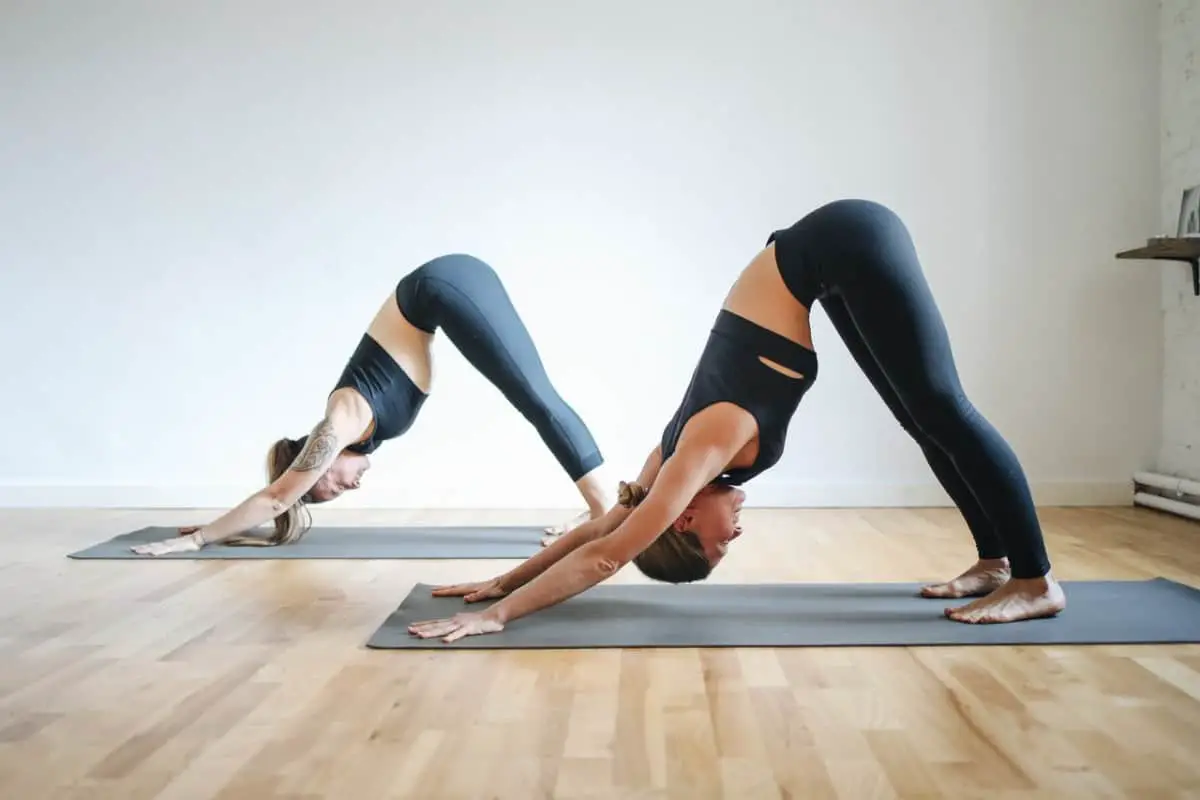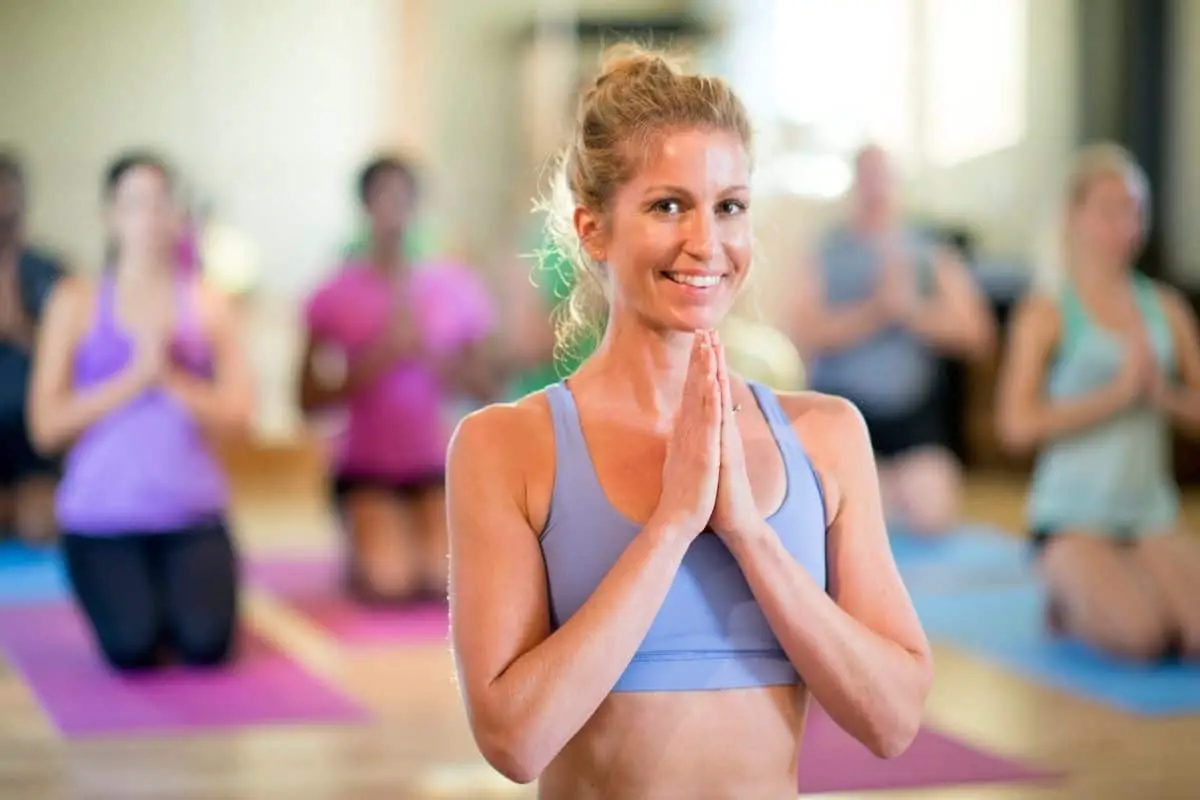Downward Dog, also known as Downward-Facing Dog – Adho Mukha Svanasana in Sanskrit – is one of the staples in any yogi’s yoga practice. This relatively simple – but powerful asana – is among the first ones beginners approach as it is often the starting point to other postures. But what if you feel nauseous during such an important and recurring pose?
You can feel nauseous in Downward-Facing Dog because you have eaten too much or too little before practice. An incorrect transition or posture can also end up compressing the abdominal muscles and organs, giving you a nauseous feeling. Breathing and resting in Child’s Pose or Savasana can help.
Downward Dog is a fundamental pose that can yield incredible benefits if practiced properly. So getting rid of the feeling of nausea is crucial to enjoying your practice more – find out the causes and solutions to this problem below.
You Have Been Feeling Unwell
If you have been feeling unwell before your yoga class, it is possible that some asanas, especially inversion might make you feel nauseous. In this case, it is recommended to interrupt your class, opt for a restoring pose, such as a Corpse Pose or Savasana. The benefits of these postures on the mind and body are endless and can help restore the essential functionalities of the body.
Additionally, not all of your practices will be the same, and listening to how your body feels at a certain point in time is crucial. While you might be able to perform a Downward Dog without troubles, sometimes, if you feel unwell, this might come more difficult. Get some rest, recover, and try again!
You Have Eaten Too Much Before Class
Our body’s well-being is deeply linked to our nutrition and eating schedule. So if you practice yoga, you should also put an emphasis on the foods you eat, striving towards a balanced, seasonal, and healthy diet.
However, the time at which you eat – especially before a yoga class – is also an extremely important factor for yogis to keep in mind. Generally, you should eat a light, balanced meal two to three hours before your yoga class.
These extended time frames give your body time to digest and absorb the nutrients needed to have maximum energy during your class. If you have eaten a larger meal just before your practice and then perform inversions, you might feel nauseous.
Indeed, every pose that requires your head to be lower than your heart space might contribute to a feeling of nausea.
You Have Not Eaten Enough That Day
One of the main benefits of practicing Downward Dog is that this pose allows you to regulate your blood pressure. It is especially effective in fighting high blood pressure, bringing it back to normal levels.
However, if you have been fasting or have not eaten during the past day, your blood pressure levels might be particularly low. In this case, practicing poses such as a Downward Dog can lower these levels even further and enhance a feeling of fatigue. These sensations can lead to a feeling of nausea.
Some Poses Might Compress Your Abdomen
If you are practicing this asana in a way that some of your abdomen muscles are compressed or in an unnatural position, you might start to feel unwell. While other poses might bring to this, it can be particularly evident during a Downward Dog because this pose is one of the most recurring during a yoga practice.
Keeping your back straight allows for deep belly breathing and bending your knees can help you restore balance and limit the feeling of nausea.
You Might Have Low Blood Pressure
Low blood pressure or hypotension is a common condition that can have severe consequences such as dizziness and fainting. If you have been diagnosed with hypotension, it is recommended to learn more about what asanas contribute to lowering blood pressure levels even further in order to avoid them.
In the case of a Downward Dog, you should know that this asana is great to fight hypertension and lower blood pressure. So if you wish to avoid a feeling of nausea and dizziness, you should swap this pose for a Child’s Pose or Savasana instead.
These poses don’t require you to have your head lower than your heart space, so you can maintain your normal blood pressure while getting all the benefits that come with resting and deep relaxation.
A Too Fast Transition Into the Pose Can Cause Nausea
Depending on the type of yoga, some transitions might happen much faster than you would want them to. Fast-paced flows, power yoga, and vinyasa are only some of the types that encourage you to move with your breath, sometimes transitioning from an asana to another with a quick, swift movement.
While there are undoubtedly some incredible benefits, this type of fast-paced yoga practice is not suitable for all yogis, and just because it is not right for you, it does not mean your practice is flawed.
Instead, keep the asanas you are practicing now but for a slower, more meditative, and balanced practice that agrees more with your body and mind.
Not Performing Downward Dog Correctly Can Make You Sick
When practicing yoga, it is crucial to find what feels good for your own body type. This means that often, you will need to allow for variations or modifications. Sometimes, it is also recommended to opt for a different or preparatory asana instead of forcing a difficult posture on your body.
However, when finding the right posture for you, it is recommended to follow the advice of a professional yoga teacher or instructor. Indeed, in this practice, there are many poses that can lead to health problems if not performed correctly or with the right preparation.
In the case of a Downward Dog, starting with basic instructions can help you avoid mistakes that can lead to pain or discomfort. Find out how to practice it correctly in the last section of this article.
Your Body Might Not Be Ready to Perform Downward Dog
Among yoga teachers, there is a debate regarding whether the Downward Dog pose is suitable for beginner yogis or not. While you can attempt this posture, it can sometimes be intimidating, and due to the great potential it can have, it is essential to understand more about yoga before nailing it.
Just like in the case of most other asanas in yoga, you will need to listen to your body to understand whether you are ready to try a new posture. This is not different from when you are approaching the Downward Dog.
Indeed, while some yogis feel comfortable in this pose since their first yoga classes, not all bodies are the same. Giving your body time to adapt, detox, and rebalance is crucial before attempting something so powerful as the Downward Dog posture.
How to Stop Feeling Nauseated in a Downward Dog
Being clear about the factors that could cause you to feel nauseous or dizzy in this pose is the first step in figuring out a solution to this issue. However, you can find quick solutions to experiment with below.
Change Your Eating Schedule
Among the most common causes of beginner yogis feeling sick while practicing Downward Dog is related to their eating habits.
If you decide to practice just after breakfast or lunch, or you opt for an evening practice after a heavy dinner, you are not likely to get all the benefits that yoga can offer you. And in some cases, you can feel sick or sluggish while practicing.
Potential solutions to this issue include:
- Change your eating schedule.
- Adjust the time at which you practice according to your meals (or vice-versa).
- Have lighter meals and wait between two to three hours before practicing.
- If you only have limited time just after you have eaten to practice, avoid inversions.
Take Some Time in Child’s Pose or Savasana
If you have adjusted your eating schedule, but you still feel nauseous when practicing Downward Dog, allow your body to rest, and get used to the feeling. While some yogis might be able to hold this pose for longer time frames since their first class, this is not always the case.
So spend some seconds in the Downward Dog pose while breathing through the belly. Then, release into Balasana (Child’s Pose) or Savasana (Corpse Pose). Both of these poses will grant you all the benefits that deep relaxation and mindfulness can offer, without the need to position your head lower than your heart space, thus reducing the feeling of nausea.
Try Again When You Feel Ready
As mentioned, not all yogis are ready for a Downward Dog from day one. Allowing your body to detox, balance itself, and get used to performing the pose is essential to finally enjoying it. Don’t rush it and use alternatives instead (see below).
Take Longer Breaths
Breathing allows you to relax your muscles and ease the feeling of discomfort you might have in certain asanas. These techniques are part of a discipline called pranayama, which refers to the rhythmic control of breathing.
Introducing pranayama techniques in your yoga practice can be an excellent way to give your body time to adapt to the feeling of a Downward Dog while reducing the feeling of nausea.
Slow Down the Transition
Sometimes, the only issue with your practice is the speed at which you perform the asanas. Due to the new forms of yoga taking over the landscape, it is possible to find fast-paced, fat-burning practices.
However, if you have been experiencing issues with dizziness and nausea, you could opt to try slower practices. These include:
If you struggle to find classes for these types of yoga in your town or area, you can also consider just slowing down your regular practice. While to get your heart rate up, you might consider coupling up yoga with other forms of exercise; this is a suitable solution to prevent discomfort or nausea.
Speak to a Yoga Teacher
One of the best you could do to ensure your practice is healthy and balanced is speaking to a professional yoga teacher or instructor. Thanks to their experience, they will help you understand whether your discomfort is due to bad alignment, or your body is simply not ready for this type of posture.
Aside from telling you more about your options and alignment, yoga gurus are helpful in indicating what alternatives to this pose you have and how to implement them. Within yoga teachers’ area of expertise is nutrition for yogis and breathing techniques. So they can be all-around helpful when it comes down to understanding what makes you nauseous while in Downward Dog.
Alternatives to Downward-Facing Dog
If your body is not ready for a Downward Dog pose just yet, some alternatives are worth considering. These are useful to experience all the benefits that a Downward-Facing Dog might offer. However, they don’t require such a drastic forward bent or inversion like in this posture.
Here are some valid alternatives to this asana.
Extended Puppy Pose
The Extended Puppy Pose is a powerful asana that comes to life from the combination of a Child’s Pose and Downward-Facing Dog. Just like the latter, the pose allows you to lengthen the spine, relax, and obtain a feeling of calmness. This is ideal to use in-between other, more intense asanas during your practice.
To practice the Extended Puppy Pose:
- Set on your mat on all fours. Your hips should be just above your knees and your shoulder above your wrists.
- Start to walk your hands forward and curl your toes.
- Exhale while moving your buttocks back, lifting it towards your heels. Keep your arms active while doing so, and keep your elbows lifted.
- Drop your head, allowing it to rest on the floor or on a blanket. This will encourage the neck to relax.
- Press the hand down and allow your arms and spine to stretch while pulling your hips towards the heels.
- Keep breathing and hold this pose for 30 seconds to a minute.
Downward Dog With Props or Against a Wall
One of the main aims of Downward Dogs is to stretch the spine and neck while offering you a feeling of relaxation. Using props or a wall to support your practice will only enhance such benefits. These are also suitable alternatives for yogis moms-to-be who need a little more support and avoid inversions.
The props you might consider for this include:
- Blankets
- Blocks
- Chairs
- Straps wedges
- Walls
You can use these props to support your heels, wrists, arms, and legs. While in the beginning, you might decide to use a wedge to lift your heels, props to support your wrists, and a strap to enhance the shoulders stretch. You might then decide to use straps to improve alignment and stretch.
How to Properly Perform Downward Dog
Correctly performing a Downward Dog is key to prevent compressing your muscles or organs and causing a feeling of nausea.
Here are seven steps to enhance your practice. However, if you are in a rush, the video below can offer clear instructions that you can follow during your practice:
- Jump on your mat and start from all fours. When doing so, make sure that your heels and knees are aligned, and your wrists are located a little forward compared to your shoulders.
- One of the most important aspects of a Downward Dog relates to the position of your hands. The whole pose will be supported by it, so you should ensure they are correctly positioned. Start by spreading your palms, ensuring that your index fingers are parallel and slightly turned outwards. Then, turn your toes under.
- As you exhale, lift your knees and hips away from the floor, sending your buttocks back and upwards. Start the movement by keeping the knees bent and the heels lifted from the floor.
- Lengthen your tailbone and press it towards the pubic. As you do so, lift your buttocks toward the ceiling and draw your inner legs inwards, up towards the groins.
- While exhaling, push the top of the thighs back and drop your heels toward the floor (you will be able to touch the floor with time). Straighten your legs and knees while doing so, but make sure you are not locking your knees.
- Make sure your outer arms are stable and press at the bases of the index fingers of both hands. This resistance will allow you to stretch your spine and strengthen your arms. Also, ensure that your shoulder blades are firmly pulled towards your back and drawn towards the tailbone.
- Keep your head and neck relaxed and in-between your arms, but make sure it does not hang. Keep the pose between one to three minutes, then release.
Conclusion
Downward Dogs can yield incredible health benefits, including relaxation, lowering blood pressure, relieving asthma and breathing conditions, and improving digestion. When practiced correctly, you can also feel a deep stretch of the shoulders and spine.
Nonetheless, it is an inversion, and if you have been feeling unwell, you have eaten too much before practice, or your body’s not ready for it, you might feel nauseous and dizzy. Speaking to a professional teacher, rearranging your eating pattern, and giving your body time to adapt are viable solutions for you to enjoy the Downward Dog pose more.
Sources
- Wikipedia: Asana
- Yoga Journal: Corpse Pose
- Five Pillars Yoga: Yoga 101: What To Eat Before Yoga Practice
- Yoga Journal: Downward-Facing Dog
- Cleveland Clinic: Fasting: How Does It Affect Your Heart and Blood Pressure?
- Mayo Clinic: Low Blood Pressure
- Harvard Health Publishing: The safe way to do yoga for back pain
- Yoga U: Yoga for Beginners: 3 Great Reasons NOT to Teach Downward-Facing Dog Pose
- Yoga Journal: Child’s Pose
- Yoga Journal: Corpse Pose
- Yoga Journal:5 Pranayama Techniques With the Power to Transform Your Practice—& Your Life
- Iynaus.org: Iyengar Yoga
- Wikipedia: Kundalini yoga
- Yoga Journal: Yin Yoga Sequences
- Yoga Journal: Restorative Yoga
- Jivamukti: Jivamukti Yoga
- Your Pace Yoga: Mad Props: Modified Downward Facing Dog
Sitasyoga.com is a participant in the Amazon Services LLC Associates Program, an affiliate advertising program designed to provide a means for sites to earn advertising fees by advertising and linking to Amazon.com. We also participate in other affiliate programs which compensate us for referring traffic.




